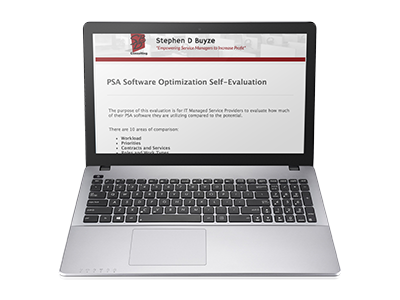Take a moment to reflect on the current status of how your Managed Services team communicates throughout the entire lifespan of a customers incident or request. No one is listening or watching, so be honest with yourself!
How much time is wasted because of confusion?
Specifically, confusion over who is responsible for what?
Not sure where to start with your thinking? Please sign up for Steve’s FREE IT Service Delivery Operations Self-Evaluation to uncover possible areas of improvement in your MSP business!

can you relate to this example?
The saga begins with a scenario that I hear told all too often. It all starts with a Customer calling in claiming that they are:
- Looking for information
- Waiting for a promised update
- Feeling totally clueless about where their issue stands
The poor person at your MSP who answered the phone in this scenario has even less information than the Customer who called in.
So, they research the Customer request ticket and see the first person who touched it, this then sends them on to the second person who worked on it, which directs them to the last person to handle it. After talking with them, they are shuffled back to the middle person because they already completed their portion of the work.
Grrr, what a confusing, frustrating loop for anyone to have to deal with!
Why is this happening (and moreover, why is this such a common issue at MSPs)?
Put simply, nobody knows because no one owns the Customer request.
Meanwhile, the fact that this call happened in the first-place likely signals that your Customer is about ready to start considering switching Service Providers!
Please sign up for Steve’s FREE IT Service Delivery Operations Self-Evaluation to uncover possible areas of improvement in your MSP business!

Back to my scenario. Management STEPS In.
After hearing about the issue. Management steps in to try to figure out what is happening and most importantly – how to assure the problem is fixed, it won’t happen again and that there is no need to look for another Service Provider! Management then usually overcompensates (with the best of intentions) and comes up with a convoluted list of rules and what ifs, trying to appease everyone – all while protecting their favorite employee involved, and dumping on the poor rep. on your team who can’t seem to do anything right. Sound familiar?
Sounds like a communication problem!
The root cause of all this confusion is poor communication – go figure. Here’s the catch: In this case, it’s not the “who knows what” communication we are talking about, but instead the proper procedural communications that should have been written way up front – months before the Customer request came in (and should have been in place on day one). Until your Managed Service Provider business gets to the point where you and your team realize this, you can expect:
-
- Customers to leave for a ‘better’ MSP
- Stress/chaos levels driving Employees out of the company
- Decreased profits as compared to your competitors
- A (big) struggle to be best in class
There is a simple solution for every MSP.
The mere thought of these occurrences is frightening, but in reality, there IS a simple solution: The first person on your team who touches a ticket owns that ticket all the way through the process. This person can be technical or non-technical.
First, they are the ones that communicated with the Customer or received the info collected at the time the request was taken in. The Customer was likely promised that “we will get right on it” or “we will move it to the top of the queue.”
Second, if the intake person did not ask the right questions, they need to be educated on what information is needed, and required to go back to the Customer and ask the right questions. This way, they learn what questions to ask, and in the future they will do it better the first time (because none of us have the time to do it twice). The rep. will also be motivated to update your call sheet or ‘Request for Information’ notification.
Third, the first person knows who they handed the request off to. They can easily shepherd it through the system using a variety of tools (widgets). As long as the request stays on the SLA track, there is nothing for them to do; except sit back and drink Pina Coladas (or whatever your team enjoys during working hours). The minute the request goes sideways, your PSA Automation can alert them so they can jump into action; finding out what needs to be done, and updating the Customer immediately.
Finally, if the procedures clearly call out, and management overly communicates (wait scratch that, we are now expecting too much – we are expecting communications to fix a communications problem)… If the procedures clearly call out the steps necessary, and management overly coaches and mentors the Support Team, they will know that the first person touching or intaking a request owns it, and they are expected to shepherd it through the Customer request life cycle Cradle to Grave! This results in:
-
- Less confusion
- Less Waste
- Happier Employees
- Happier Customers
- More money for the Company
Never deal with a disappointed Incident Customer again. The bottom-line is this:
-
- Establish a simple and clear first touch ownership policy.
- Consistently hold people accountable.
- Empower them to do something about it.
- Sit back and watch the work get done.
Follow these few simple steps and you’ll likely never have to deal with a disappointed Customer again (well, hopefully never).
Please sign up for Steve’s FREE IT Service Delivery Operations Self-Evaluation to uncover possible areas of improvement in your MSP business!

Now let’s re-run the scenario this time with the first person owning the Customer’s request…
The person in taking the request:
- Asks the right questions upfront.
- Takes the information down; properly fills in the ticket.
- Shepherds the request to remediation within a realistic
- Updates the Customer in a timely fashion.
They place the ticket in the proper workflow as well as on their Dashboard to monitor the request flow based on activity vs. expectations (Service Level Agreement management).
As long as the request is hitting its marks, and updates are being given to the Customer as expected, they have no extra work.
Voilà – No call from an unhappy Customer!

Meet Steve. Learn How He Can Help!
We trust that we have just painted the picture of your IT Service Delivery operations in our second scenario. Yes? No? Prefer not to state? If you’d like a second opinion on how your team operates.
Steve is ready to help! Contact Steve immediately.
Either way, do yourself a favor and sign up for Steve’s FREE IT Service Delivery Operations Self-Evaluation to uncover possible areas of improvement in your MSP business!. After all, continual improvement is the only way to achieve your goals!

Sign up below to receive our monthly IT Services advice + other cool stuff straight to your inbox.